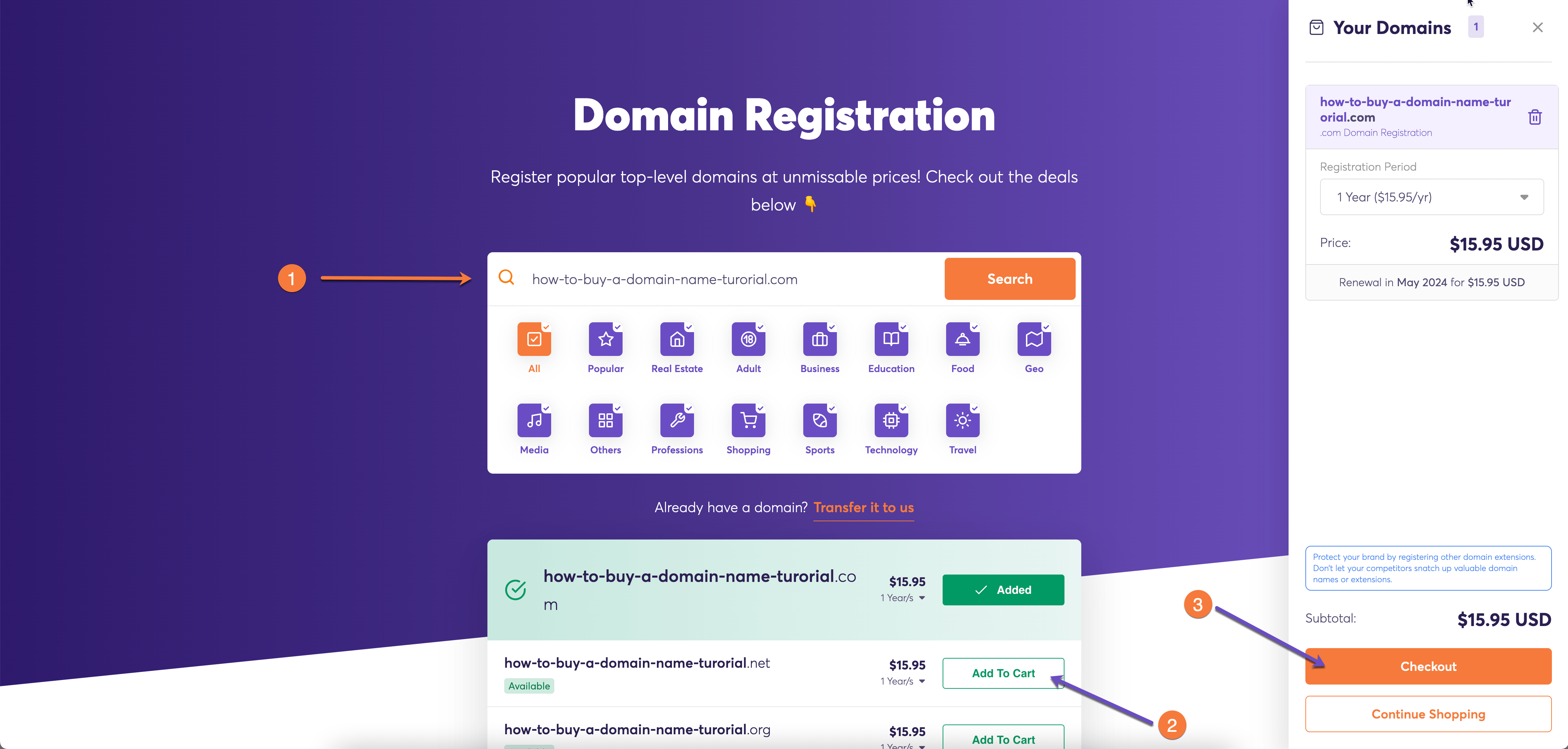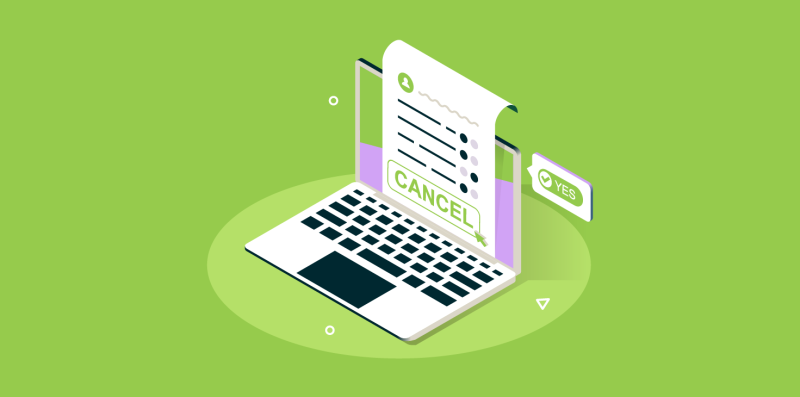
When it comes to establishing an online presence, learning how to buy a domain name is one of the first crucial steps. In this guide, we’ll provide a comprehensive overview of how to purchase your ideal domain name.
To start, we’ll provide insight into the fundamentals of domain names and their significance in developing your unique identity. Next, we’ll discuss how to research different registrar options and extensions that best suit your needs.
Finally, before you take the plunge into owning your very own domain name, there are a few things to consider. In this article, you will find information on how to purchase a domain name, advice on domain name pricing, and what to do once you’ve made your purchase. Additionally, guidance will be provided for those wishing to buy an already-taken domain name.
Table of Contents
Let’s begin!
Understand the Basics of Domain Names
Before you dive into purchasing a domain name, it’s essential to understand what they are and why you need one. A domain name is your website’s address online, making it easier for users to find and access your site. It acts as a human-readable version of an IP address, which consists of numbers that computers use to identify each other on the network.
What Is a Domain Name?
A domain name is the digital address of your website. It is the part of the URL that comes after the “www.” and ends in a particular extension such as .com, .org, .net, .biz, or .info. It is used to identify your website on the internet and makes it easy for people to find your site online.
For example, our domain name is «chemicloud.com.»
The TLD, located at the end of a web address (e.g., .com, .org), and the SLD – your unique identifier or brand (e.g., example.com) – are the two parts that make up a domain name’s two primary components.
Domain names are unique, meaning no two websites can have the same domain name. This ensures that each website is easily identifiable and accessible to users.
How Do Domain Names Work?
To better grasp how domain names work, think about them like phone contacts in your smartphone – instead of memorizing everyone’s phone number, you save their names as contacts for easy recall when needed.
In this analogy:
- Your contact list = DNS servers
- Contact names = Domain names
- Phone numbers = IP addresses
The process starts with typing a URL into your browser; then, DNS servers translate that human-friendly text into machine-readable IP addresses so browsers can locate and display the requested content.
Why is a Domain Name Important?
Purchasing a custom domain name offers several benefits:
- Professionalism: A personalized web address makes your business appear more professional than using free subdomains provided by hosting platforms.
- Brand Identity: A unique domain name helps establish your brand identity, making it easier for customers to remember and find you online.
- SEO Advantages: Search engines like Google consider custom domains as an indicator of credibility and authority, which can improve your website’s search rankings.
In summary, a domain name is crucial for establishing a solid online presence. It is the foundation upon which you build your website and grow your business or personal brand.
Grasping the rudiments of website addresses is essential for those wishing to make an online presence. With your basic knowledge of domain names in hand, it’s time to start exploring the possibilities and selecting an optimal name for your website.
Things to Consider Before Buying a Domain Name
Carefully selecting the ideal domain name is a worthwhile investment. Just like when picking out paint colors and home decorations, you want your domain to be perfect.
Utilizing the following tips can help simplify the process of choosing a domain for your website.
1. Keep It Short and Simple
Avoid using lengthy or complicated words in your domain name to ensure that users can easily remember and type it into their browsers. Aim for a maximum of 15 characters if possible.
2. Use Keywords Wisely
Incorporate keywords related to your niche or industry within the domain name when appropriate; this can help with search engine optimization (SEO) efforts and clarify what your website is about.
3. Avoid Hyphens and Numbers
Domain names containing hyphens or numbers may be harder to remember or prone to typos by users trying to access your site directly through their browser’s address bar.
4. Consider Your Target Audience
If you are targeting a specific country or region, consider using a country code top-level domain (ccTLD), such as .us for United States-based businesses, .co.uk for those in the UK, etc., which might appeal more directly to local customers.
5. Consider your area of expertise
To make sure that customers know what products and services you offer, it is important to select the right domain extension for your business. For instance, a .photography extension can indicate that you are in the photography industry, while a .edu extended domain generally conveys educational activities. With such specific extensions, it is much simpler to communicate exactly what your company does.
6. Check Availability Across Social Media Platforms
To maintain consistency across all platforms where you have an online presence – like social media channels – check whether usernames similar to your chosen domain are available before finalizing any decisions.
7. Good, not perfect
It is a common misconception that entrepreneurs should be fixated on finding the perfect domain name when launching their business. Channeling the same energy toward building your brand is often much more productive.
Therefore, don’t let the quest for an ideal web address prevent you from embarking on your journey as an entrepreneur or creator.
Once you’ve considered these factors carefully and brainstormed some potential options based on them, use a similar tool to check the availability of your desired domain name.
If the desired domain name is unavailable, you may need to be inventive and develop alternate choices that still satisfy the abovementioned criteria.
Lack of inspiration? Use a Domain Name Generator
Using an automated domain name generator can be an effective way to generate ideas for potential domain names. An example of such is Domain Wheel, which guarantees that it only provides suggestions that are still available.
Domain Wheel can help make this process easier by providing a keyword-based search engine to assist in selecting a suitable name. Enter one or more ideas into the tool, and you will be presented with several alternative suggestions relevant to your query.
Remember, selecting a domain name is essential to influence your web presence for the long haul. Take your time and select one that best represents your brand while being easy for users to find and remember.
How to Buy a Domain Name in 5 Easy Steps
To complete the process, it’s time to register that chosen domain name with a registrar. Before buying a domain name, exploring the various domain registrars available in the market is essential.
Step 1) Research Your Options
Choosing the right domain registrar is an important decision for your website. A domain registrar is essentially the gatekeeper for your website’s address, so you want to make sure you choose a reputable company that will help you with any issues that may arise.
a) Compare Pricing and Features
Different registrars offer varying prices for registering or renewing domain names. It’s crucial to compare their fees and any additional features they provide before deciding. When comparing these services, consider factors such as:
- Domain registration cost (for one year or multiple years)
- Rates for renewal after the initial term expires
- Add-on services like privacy protection or email hosting
- Promotions or discounts on first-time registrations or transfers from other providers
b) Evaluate Customer Support Quality
A good registrar should have an efficient customer support system in place so that you can get assistance whenever needed. Look for reviews online about their response time and helpfulness when resolving issues related to your domain name management.

c) Check Domain Transfer Policies
If you decide to switch registrars later on, it’s essential to know the transfer policies of your chosen provider. Some registrars may charge a fee for transferring domains, while others might have specific requirements or waiting periods before you can initiate a transfer.
d) Assess Security Measures
Security is an essential aspect when choosing a domain registrar. Ensure the company offers features like two-factor authentication (2FA) and secure account management options to protect your domain from unauthorized access or potential cyber threats.
Domain registrars also provide various additional services, such as domain privacy protection, email hosting, and website-building tools.
Researching your options is key to finding the right domain registrar. Now it’s time to move on to registering a domain name.
Step 2) Check Domain Availability & Pricing
Normally you must pay top dollar to any domain registrar to get your domain name. However, we’re proud to be the only company to offer a free domain when you purchase any of our web hosting plans.
Once you’ve settled on a registrar or web host from which to buy your domain, you’ll want to search for a domain to check its availability. This is the next step in the process.
Verify the desired domain name is available by searching on the registrar’s site or app before continuing with registration.
Suppose it’s available – great. Take note of its price as well since different registrars may offer varying prices for similar domains.
If your desired address is taken, consider alternative top-level domains. It used to be that .com was the go-to domain ending, but now there are many more TLDs (top-level domains) out there than ever before. From .agency to .organic and even .vet, there’s an array of possibilities for anyone wanting something new and exciting.
To buy a domain at ChemiCloud, continue the process from the domain checker page and click the Add to Cart button next to your chosen domain.
The next step is selecting your registration period. Your registrar typically determines this and can range from one to ten years. As the initial registration comes close to expiring, you will be notified that it needs to be renewed.
Then, click the Checkout button to continue.

Step 3) Add Privacy Protection (Optional)
Use domain privacy protection if you are concerned about your privacy and don’t want your personal information publicly available.
- What: Privacy protection helps keep your personal information private by masking details like names and addresses from public WHOIS records associated with registered domains.
- Why: It can help protect you from spam, identity theft, and other unwanted solicitations.
- How: Many registrars offer privacy protection as an add-on service during the registration process.

Click on the Continue button.
Step 4) Complete the Registration Process
Once you reach the checkout process, you’ll need to provide your with your registrant information, such as:
- Name:
- Address:
- Organization Name:
- Email address:
- Phone number:
Afterward, select the payment method, and review the order. Once finished, click Checkout to complete the domain registration process.
Step 5) Verify Domain Name Ownership
Once you have completed registering your domain, it is essential to verify that you are in fact its rightful owner. This verification can be done via an email sent to you that would typically arrive within minutes of completing setup. To complete this task, all you need to do is click on a link in the email to confirm your contact information.
It is essential to take action promptly in this matter: postponing your domain ownership verification for 15 days or more could lead to its temporary suspension from the registry.
How to Buy a Domain Name That’s Already Taken
If you’ve ever tried to buy a domain name for your website only to find that it’s already taken, you’re not alone. Fortunately, there are strategies you can use to buy a domain name that’s already taken. In this article, we’ll explore the process of researching, contacting, and negotiating with domain name owners to help you secure the domain you want for your website.
Identifying the Domain Owner
The first step in acquiring a domain name that’s taken is to identify its owner. You can use WHOIS lookup tools or check for contact information on the website itself. Once the owner is identified, one can reach out and enquire about purchasing it.
Using WHOIS Lookup Tools to Find Domain Ownership Details
WHOIS lookup tools permit users to explore and display the details of registered domains, such as registrant names, emails, and phone numbers.
Checking for Contact Information on the Website
If a website has been developed under your dream domain, look for an «About Us,» «Contact Us,» or similar page where you might find direct communication options with the current owner of that perfect domain.
Once you have identified the domain owner, it is important to determine your budget and appraise the domain’s value before initiating negotiations.
Determining Your Budget and Appraising Domain Value
Before contacting the owner, determine your budget for acquiring this specific domain name. Use an appraisal service like Flippa and Sedo to know what similar domains are selling for in today’s market conditions. This helps ensure fair negotiations based on comparable sales data.
Analyze your financial resources and decide how much you will invest in purchasing the perfect domain name. Having a clear budget will help streamline the negotiation process.
Negotiating and Purchasing
When negotiating terms of purchase with a seller, it is essential to ensure that both parties feel comfortable. One way to do this is by using secure platforms such as Escrow.com or similar. These services ensure that funds are held until all agreed-upon conditions are met during transactions between buyers and sellers alike.
Importance of using secure transaction platforms like Escrow.com: This platform provides peace of mind for both parties involved in the domain transfer process by holding funds securely until ownership is successfully transferred.
Considering Backordering Services
If direct negotiation fails or isn’t possible due to privacy protection measures set by registrars, consider back ordering services. These services monitor expiring domains closely and automatically attempt registering them once they become available again after expiration periods end without renewal action taken beforehand. This effectively gives clients first dibs opportunities before others even realize these valuable online properties exist.
Considering backordering services is a great way to acquire domains that are already taken. Conversely, it is prudent to investigate other potential domain names and TLDs to identify the most suitable option for your website.
Exploring Alternative Domain Names and TLDs
If acquiring your preferred top-level-domain (TLD) proves too difficult or expensive, remember there are countless other viable options worth exploring. You could choose a different TLD for your domain name or slightly modify the original name to find an available alternative.
Choosing Alternative TLDs like .io/.co/.ai etc.
Consider registering your website with less common top-level domains, such as .io, .co, or .ai. These alternatives can provide unique branding opportunities while maintaining a professional online presence.
Modifying Existing Words/Phrases Using Clever Wordplay Techniques
Create a memorable and distinctive domain by incorporating wordplay techniques like alliteration, rhyming, or combining words. Rather than opting for «TechSolutions.com,» consider snagging «TechTactics.com» if it’s available. This approach allows you to secure a great domain without sacrificing the essence of your desired name.
Buying a domain name that’s already taken can seem like a daunting task, but with the right approach, it’s possible to secure the domain name you want for your website.
How to Buy a Domain Name FAQs
What’s the difference between buying a domain and a hosting package?
A domain name is like your website’s street address. It helps people find your site online. Web hosting is like your website’s home – it’s where your site’s files, images, and other information are stored. Your site needs an address and a home to be up and running. But they are definitely two different things.
Can I buy a domain name without hosting?
Buying a domain name does not need a hosting plan – these are two distinct services. To get started, check the availability of your chosen name and purchase it via a domain registrar.
How to get a domain name for free?
You must purchase one of our annual hosting plans for a free domain name. Check out our hosting plans and pricing . Free domain registration is available for the first year only.
What are you waiting for? Claim your free domain and get yourself online.
Is Domain Name Privacy Protection worth it?
Short answer: yes!
When you register a domain, your personal contact information (such as your name, address, and phone number) is typically added to the WHOIS database, which is a public directory of domain name registrants. If you are concerned about your privacy and don’t want your personal information to be publicly available, you should definitely consider using domain privacy protection.
Should I Buy Domain and Hosting separately or together?
There is no one-size-fits-all answer to this question, as it depends on individual preferences and requirements. It’s essential to choose a reliable domain provider who can provide quality service at an affordable price when buying a domain name for yourself or your business; this will ensure that everything runs smoothly from start to finish with no unexpected issues along the way. Similarly, selecting a reputable web hosting provider will help guarantee maximum uptime and performance for everyone visiting or using your site – regardless if it’s just you alone accessing it or thousands of others simultaneously doing so.
Conclusion
Comprehending the rudiments of domain names and investigating your selections can aid you in selecting the ideal domain name for your website. Once you’ve made a decision, registering your domain name is easy and affordable.
⏭️ Please join us in the following tutorial, where we will walk you through How to Transfer a Domain Name: A Step-by-Step Guide



